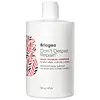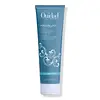What's inside
What's inside
 Benefits
Benefits

 Concerns
Concerns

 Ingredients Side-by-side
Ingredients Side-by-side

Water
Skin ConditioningGlycerin
HumectantEthylhexyl Palmitate
EmollientBehentrimonium Chloride
PreservativeGlycine Soja Oil
EmollientBrassica Alcohol
EmollientCetyl Alcohol
EmollientStearyl Alcohol
EmollientSodium PCA
HumectantArgania Spinosa Kernel Oil
EmollientLaminaria Saccharina Extract
Skin ProtectingPanthenol
Skin ConditioningAloe Barbadensis Leaf Juice
Skin ConditioningBrassicyl Isoleucinate Esylate
Emulsion StabilisingPrunus Amygdalus Dulcis Oil
Skin ConditioningChamomilla Recutita Flower Extract
MaskingSantalum Album Oil
MaskingAmyris Balsamifera Bark Oil
MaskingPogostemon Cablin Leaf Oil
MaskingElettaria Cardamomum Seed Oil
MaskingFerula Galbaniflua Resin Oil
AntimicrobialGuar Hydroxypropyltrimonium Chloride
Skin ConditioningCetrimonium Chloride
AntimicrobialArginine
MaskingBiotin
AntiseborrhoeicCocos Nucifera Oil
MaskingButyrospermum Parkii Butter
Skin ConditioningSorbitan Oleate Decylglucoside Crosspolymer
CleansingRosa Canina Fruit Oil
EmollientAlgin
MaskingCaprylic/Capric Triglyceride
MaskingChitosan
Citric Acid
BufferingPotassium Sorbate
PreservativeSodium Benzoate
MaskingParfum
MaskingDehydroacetic Acid
PreservativeBenzyl Alcohol
PerfumingWater, Glycerin, Ethylhexyl Palmitate, Behentrimonium Chloride, Glycine Soja Oil, Brassica Alcohol, Cetyl Alcohol, Stearyl Alcohol, Sodium PCA, Argania Spinosa Kernel Oil, Laminaria Saccharina Extract, Panthenol, Aloe Barbadensis Leaf Juice, Brassicyl Isoleucinate Esylate, Prunus Amygdalus Dulcis Oil, Chamomilla Recutita Flower Extract, Santalum Album Oil, Amyris Balsamifera Bark Oil, Pogostemon Cablin Leaf Oil, Elettaria Cardamomum Seed Oil, Ferula Galbaniflua Resin Oil, Guar Hydroxypropyltrimonium Chloride, Cetrimonium Chloride, Arginine, Biotin, Cocos Nucifera Oil, Butyrospermum Parkii Butter, Sorbitan Oleate Decylglucoside Crosspolymer, Rosa Canina Fruit Oil, Algin, Caprylic/Capric Triglyceride, Chitosan, Citric Acid, Potassium Sorbate, Sodium Benzoate, Parfum, Dehydroacetic Acid, Benzyl Alcohol
Water
Skin ConditioningCetearyl Alcohol
EmollientGlycerin
HumectantCetrimonium Chloride
AntimicrobialOlea Europaea Fruit Oil
MaskingAcetamide Mea
HumectantMacadamia Ternifolia Seed Oil
EmollientHelianthus Annuus Seed Oil
EmollientPanthenol
Skin ConditioningArgania Spinosa Kernel Oil
EmollientPolyquaternium-37
Dicaprylyl Carbonate
EmollientLauryl Glucoside
CleansingAmodimethicone
Trideceth-12
EmulsifyingCeteareth-20
CleansingCetrimonium Methosulfate
AntimicrobialQuaternium-91
Citric Acid
BufferingDisodium EDTA
Ethylhexylglycerin
Skin ConditioningPhenoxyethanol
PreservativeDMDM Hydantoin
PreservativeIodopropynyl Butylcarbamate
PreservativeParfum
MaskingBenzyl Benzoate
AntimicrobialHexyl Cinnamal
PerfumingLimonene
PerfumingLinalool
PerfumingWater, Cetearyl Alcohol, Glycerin, Cetrimonium Chloride, Olea Europaea Fruit Oil, Acetamide Mea, Macadamia Ternifolia Seed Oil, Helianthus Annuus Seed Oil, Panthenol, Argania Spinosa Kernel Oil, Polyquaternium-37, Dicaprylyl Carbonate, Lauryl Glucoside, Amodimethicone, Trideceth-12, Ceteareth-20, Cetrimonium Methosulfate, Quaternium-91, Citric Acid, Disodium EDTA, Ethylhexylglycerin, Phenoxyethanol, DMDM Hydantoin, Iodopropynyl Butylcarbamate, Parfum, Benzyl Benzoate, Hexyl Cinnamal, Limonene, Linalool
Ingredients Explained
These ingredients are found in both products.
Ingredients higher up in an ingredient list are typically present in a larger amount.
You may know this ingredient as argan oil. Argan Oil has antioxidant, hydrating, and soothing properties.
Studies have shown argan oil can help fight again radical damage from the sun. This makes it effective at preventing hyperpigmentation.
Large amounts of vitamin E found in argan oil helps the skin retain water. Argan oil also contains fatty acids such as linoleic acid, oleic acid, and palmitic acid. It is also a good source of lipids.
Another benefit of argan oil is skin-soothing. It can help reduce inflammation-related skin symptoms.
Argan Oil is effective at regulating sebum production in pores. This can make it effective at treating hormonal acne.
Traditionally, argan oil was used for its antibacterial and antifungal properties. However, argan oil contains fatty acids that may make it not fungal-acne safe.
Argan Trees are native to Morocco.
Learn more about Argania Spinosa Kernel OilThis ingredient is a preservative, antimicrobial, and emulsifier. It is often used in cosmetics for its ability to cleanse, condition, and reduce static.
Cetrimonium chloride is a quaternary ammonium salt, meaning it has a water-soluble structure.
Citric Acid is an alpha hydroxy acid (AHA) naturally found in citrus fruits like oranges, lemons, and limes.
Like other AHAs, citric acid can exfoliate skin by breaking down the bonds that hold dead skin cells together. This helps reveal smoother and brighter skin underneath.
However, this exfoliating effect only happens at high concentrations (20%) which can be hard to find in cosmetic products.
Due to this, citric acid is usually included in small amounts as a pH adjuster. This helps keep products slightly more acidic and compatible with skin's natural pH.
In skincare formulas, citric acid can:
While it can provide some skin benefits, research shows lactic acid and glycolic acid are generally more effective and less irritating exfoliants.
Most citric acid used in skincare today is made by fermenting sugars (usually from molasses). This synthetic version is identical to the natural citrus form but easier to stabilize and use in formulations.
Read more about some other popular AHA's here:
Learn more about Citric AcidGlycerin is already naturally found in your skin. It helps moisturize and protect your skin.
A study from 2016 found glycerin to be more effective as a humectant than AHAs and hyaluronic acid.
As a humectant, it helps the skin stay hydrated by pulling moisture to your skin. The low molecular weight of glycerin allows it to pull moisture into the deeper layers of your skin.
Hydrated skin improves your skin barrier; Your skin barrier helps protect against irritants and bacteria.
Glycerin has also been found to have antimicrobial and antiviral properties. Due to these properties, glycerin is often used in wound and burn treatments.
In cosmetics, glycerin is usually derived from plants such as soybean or palm. However, it can also be sourced from animals, such as tallow or animal fat.
This ingredient is organic, colorless, odorless, and non-toxic.
Glycerin is the name for this ingredient in American English. British English uses Glycerol/Glycerine.
Learn more about GlycerinPanthenol is a common ingredient that helps hydrate and soothe the skin. It is found naturally in our skin and hair.
There are two forms of panthenol: D and L.
D-panthenol is also known as dexpanthenol. Most cosmetics use dexpanthenol or a mixture of D and L-panthenol.
Panthenol is famous due to its ability to go deeper into the skin's layers. Using this ingredient has numerous pros (and no cons):
Like hyaluronic acid, panthenol is a humectant. Humectants are able to bind and hold large amounts of water to keep skin hydrated.
This ingredient works well for wound healing. It works by increasing tissue in the wound and helps close open wounds.
Once oxidized, panthenol converts to pantothenic acid. Panthothenic acid is found in all living cells.
This ingredient is also referred to as pro-vitamin B5.
Learn more about PanthenolParfum is a catch-all term for an ingredient or more that is used to give a scent to products.
Also called "fragrance", this ingredient can be a blend of hundreds of chemicals or plant oils. This means every product with "fragrance" or "parfum" in the ingredients list is a different mixture.
For instance, Habanolide is a proprietary trade name for a specific aroma chemical. When used as a fragrance ingredient in cosmetics, most aroma chemicals fall under the broad labeling category of “FRAGRANCE” or “PARFUM” according to EU and US regulations.
The term 'parfum' or 'fragrance' is not regulated in many countries. In many cases, it is up to the brand to define this term.
For instance, many brands choose to label themselves as "fragrance-free" because they are not using synthetic fragrances. However, their products may still contain ingredients such as essential oils that are considered a fragrance by INCI standards.
One example is Calendula flower extract. Calendula is an essential oil that still imparts a scent or 'fragrance'.
Depending on the blend, the ingredients in the mixture can cause allergies and sensitivities on the skin. Some ingredients that are known EU allergens include linalool and citronellol.
Parfum can also be used to mask or cover an unpleasant scent.
The bottom line is: not all fragrances/parfum/ingredients are created equally. If you are worried about fragrances, we recommend taking a closer look at an ingredient. And of course, we always recommend speaking with a professional.
Learn more about ParfumWater. It's the most common cosmetic ingredient of all. You'll usually see it at the top of ingredient lists, meaning that it makes up the largest part of the product.
So why is it so popular? Water most often acts as a solvent - this means that it helps dissolve other ingredients into the formulation.
You'll also recognize water as that liquid we all need to stay alive. If you see this, drink a glass of water. Stay hydrated!
Learn more about Water